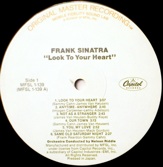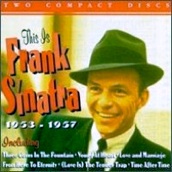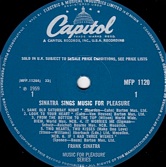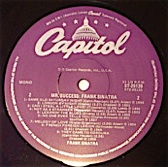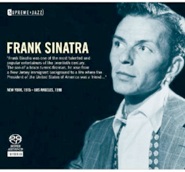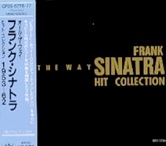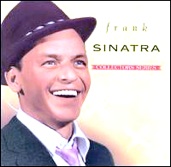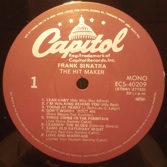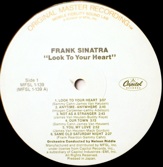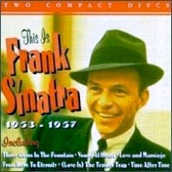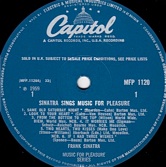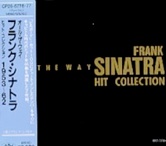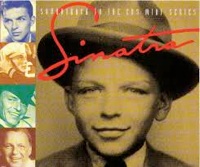Non-Album Tracks, 1955
Thank you to SHTV’s “Bob F” for his invaluable assistance in compiling this information.
Ongoing discussion at the Steve Hoffman Music Forum (LINK)
Album Index <---- 1954 Sessions 1955 Singles: March 4 March 7 March 23 July 29 August 19 September 13 October 17 October 31 ----> 1956 Sessions
July 29, 1955 -
Same Old Saturday Night / Fairy Tale
Song #1:
“Same Old Saturday Night”
Top Choice:
•The Hit Maker LP
Not as good:
•D1 45 - heavily compressed
•Every other version: wrong tapes
Avoid:
•Hit Collection CD - stereo playback, slightly bright, dropouts, wrong tapes
•Complete Capitol Singles - Norberged; wrong tapes
•Supreme Jazz - Heavily processed re-use of Collectors Series mastering
•This is Frank Sinatra, 1954-1957 - very bright EQ; wrong tapes
•UK Look to Your Heart CD - brighter than some; wrong tapes.
•Sinatra Sings Music for Pleasure - extra compression; wrong tapes
NOTES
•Look to Your Heart LP tapes have once again run roughshod over a title’s release history. (This has happened repeatedly with singles that later appeared on that LP.)
•Because even Bob Norberg’s mastering did not use the correct tapes, one must suspect that the session masters for this album are not available/usable.
•See additional notes farther down the page.
Audio Clips
Arranger/Conductor: Nelson Riddle
Original Release: #3218, August 29, 1955
Original LP Release:
Look to Your Heart LP, 1959
Original CD Release:
Japan All the Way: Hit Collection, 1989
Releases sampled for this comparison:
•1955 D1 45
•1959 Look to Your Heart LP
•1959 UK Sinatra Sings Music for Pleasure LP
•1980s Australia Mr. Success LP
•1982 Japan The Hit Maker LP
•1983 MFSL Look to Your Heart LP
•1984 UK Look to Your Heart LP
•1989 Japan All the Way: The Hit Collection CD
•1989 Collectors Series CD*
•1991 All-Time Favorites by Frank Sinatra CD*
•1994 UK This is Frank Sinatra 1953-1957 CD
•1995 Sinatra 80th: All the Best CD*
•1996 Complete Capitol Singles CD
•1998 UK Look to Your Heart CD
•1998 36 All-Time Favorites CD*
•1998 Australia Frank Sinatra Collection CD*
•2006 Supreme Jazz SACD (unlicensed)
*Shared mastering
Song #2:
“Fairy Tale”

SAMPLE AUDIO CLIPS
All clips for this song mirror those freely available via Amazon.com.

SAMPLE AUDIO CLIPS
All clips posted here mirror those freely available via iTunes. To access the 90-second iTunes free samples, click
“View,” then “View in iTunes.”

Above: 1998 UK Look to Your Heart CD, courtesy “rangerjohn.”
Above: 1996 Complete Capitol Singles CD, mastered by Bob Norberg, courtesy “rangerjohn”.
Above: 1983 MFSL Look to Your Heart LP, mastered by Jack Hunt
Above: 1984 Look to Your Heart UK LP, courtesy “Sinatrafan”
Above: 1994 UK This is Frank Sinatra 1953-1957 CD.
Above: 1959 UK Sinatra Sings Music for Pleasure LP
Above: D1 45, courtesy stevelucille
Above: 1980s Australia Mr. Success LP
Above: 1989 Japan Hit Collection CD, courtesy “progrockfan”
Above: 1989 Collectors Series CD, reused in The Capitol Years, Sinatra 80th: All the Best, etc.
Above: 2006 unlicensed Supreme Jazz SACD, courtesy OldCoder.
Above: 1982 Japan The Hit Maker LP
“The Importance of The Hit Maker LP”
or
“John Garfield Is Usually More Handsome Than That”
I find it hard to overstate how revelatory the sound quality on The Hit Maker LP is for this track, but it’s something that is a little hard to convey within the confines of the 30-second clip that is posted at iTunes, and I don’t wish to have a legal visit from Sinatra, Inc, so I’m going to play the hand I’ve been dealt and go no further, regardless of the temptation to do just that. To some degree, you’ll just have to take my word for it: The Hit Maker is the only LP or CD release of this track to use correct tape sources, and the difference between this version and all others, when the entire track is heard, is like night and day, I’m not exaggerating.
I’ve spoken several times recently about the way singles tracks that appeared on the 1959 Look to Your Heart compilation have been handled over the years, as they have almost always been remastered not from session tapes, but rather from tampered Look to Your Heart LP masters. I often use the phrase “hit with the ugly stick,” because it’s not just that they were EQd, but they were unpleasantly EQd; it’s not just that they were compressed, but they were unflatteringly compressed; and yet, these differences, while obvious once detected, are frustratingly subtle at times, and can be overcome somewhat with sympathetic mastering. Perhaps it would be more accurate to say that the tracks were “gently tapped with the ugly stick.”
There have been a few songs that have been mercifully spared this fate on recent CD reissues that used the true session masters, but the vast, vast majority of appearances have been in negatively altered Look to Your Heart form.
...and so we come to track seven on side one of 1982’s The Hit Maker LP, and I can’t help but ask: How is it that this LP -- and this LP exclusively -- was sourced from untampered tapes? Why have no US-based compilations used the correct tapes, even the Norberg release? For starters, I think there was one other use of the correct tapes, albeit a horribly compressed use: The original 45 RPM release from 1955. Here is a clip that starts with the D1 45, then transitions to The Hit Maker at the second syllable in the word “alone:” SameOldD1 45-HitMaker.mp3. Aside from compression, those two sources sound identical to me.
From there on out, over about a forty year period, we find a myriad of releases that are all virtually identical in terms of dynamics and reverb, some very well mastered (despite the use of wrong tapes), and some poorly mastered, but all sourced similarly, with the same compression, same reverb, etc. -- except for The Hit Maker!
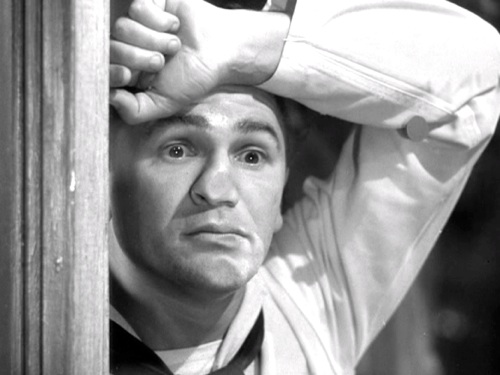
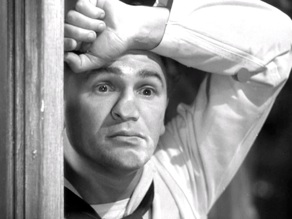
So, what’s the difference?
To me, it’s like the shot from the 1944 film Destination, Tokyo, shown at right. That’s the great John Garfield, obviously, but is that really how John Garfield looks? We can see that it’s John Garfield’s face, and nothing looks really out of the ordinary, but if you were to meet John Garfield walking down the street, would his nose be flat on the front? How about his lip? His chin? Would they have those flattened spots? Of course they would not, yet the photo is still clearly John Garfield, but in a slightly altered version. That’s how this recording is on “the usual” versions. It’s still John Garfield, but it’s John Garfield with his face pressed against the glass. It’s subtle, but it’s also the cause of a distortion of his usual visage.
Let me try to illustrate with a transition clip that uses the same 30-second iTunes segment, a clip that should convey something like this:
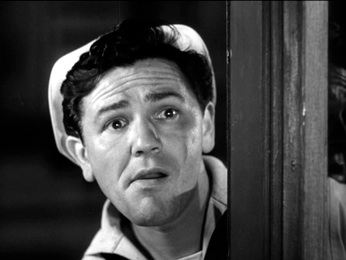
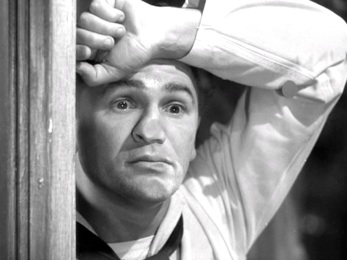
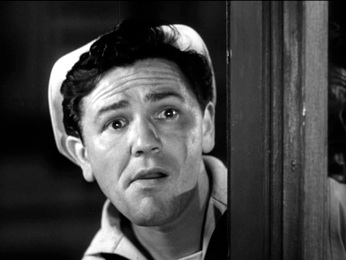
It starts with a pleasantly non-deformed John Garfield:
•I really thought that the papers I bought would help me forget you for a while. Believe me honey, the”
The middle ten seconds are “John Garfield pressed on glass:”
•”funnies weren’t funny. They didn’t even make me smile. How I wish you’d life the phone. Fun is”
Finally, for the last ten seconds, non-deformed John Garfield returns:
•”fun but not alone. ‘Til you let me hold you tight, same old Saturday night.”
Here’s the clip: SameOldHitMaker-Collectors-HitMaker.wav
To my ears, the “non-deformed John Garfield” clips sound very relaxed and natural and open compared to the typically-mis-sourced masterings.
Here’s one more clip. This one starts with MFSL then moves to The Hit Maker with each repeated phrase. Stressed/relaxed/stressed/relaxed/stressed/relaxed -- and I think the third phrase is the most noticeable of the bunch.
Here’s the clip: SameOldMFSL-HitMaker 3segAlt space.wav
Again, when you can hear the entire song, the difference is much more obvious -- really!
By the way, here’s a John Garfield photo from Destination, Tokyo that represents just how messed up the Supreme Jazz SACD is:
Again, trust me: You really don’t want to go there!

Top Choices:
•JapanThe Hit Collection CD
•UK Look to Your Heart CD
Also excellent, but with a dropout at 2:34:
•MFSL Look to Your Heart LP
•1984 UK Look to Your Heart LP
Widest Dynamics, slightly bright:
•CBS Mini-Series Soundtrack CD
Not as good:
•D1 45 - heavily compressed
•N5 Look to Your Heart LP - mildly compressed
Avoid:
•Complete Capitol Singles - Norberged
•Original Look to Your Heart LP “D” cuts (D1-D12, at least), Sinatra Sings Music for Pleasure, and This is Frank Sinatra, 1953-1957 CD - defective (see bottom of page)
•All others - wrong tapes (compressed)
NOTES
•See in-depth comments below
Arranger/Conductor: Nelson Riddle
Original Release: #3218, August 29, 1955
Original LP Release:
Look to Your Heart LP, 1959
Original CD Release:
Japan All the Way: Hit Collection, 1989
Releases sampled for this comparison:
•1955 D1 45
-
•1959 Look to Your Heart LP
•1959 UK Sinatra Sings Music for Pleasure LP
•1983 MFSL Look to Your Heart LP
•1984 UK Look to Your Heart LP
•1989 Japan All the Way: The Hit Collection CD
•1992 CBS Mini-Series Soundtrack CD
•1994 UK This is Frank Sinatra 1953-1957 CD
•1996 Complete Capitol Singles CD
•1998 UK Look to Your Heart CD
Audio Clips
Above: 1998 UK Look to Your Heart CD, courtesy “rangerjohn.”
Above: 1996 Complete Capitol Singles CD, mastered by Bob Norberg, courtesy “rangerjohn”.
Above: 1983 MFSL Look to Your Heart LP, mastered by Jack Hunt
Above: 1984 Look to Your Heart UK LP, courtesy “Sinatrafan”
Above: 1994 UK This is Frank Sinatra 1953-1957 CD.
Above: 1959 UK Sinatra Sings Music for Pleasure LP
Above: 1989 Japan Hit Collection CD, courtesy “progrockfan”
Above: 1955 D1 45
Above: 1992 Soundtrack to the CBS Mini-Series “Sinatra” Reprise CD, mastered by Lee Herschberg, courtesy “OldCoder”
Above: N1 (pressed by RCA Indianapolis) Look to Your Heart LP, courtesy “Arkoffs”
Above: N5 (pressed by RCA Indianapolis) Look to Your Heart LP, courtesy “Arkoffs”
Above: D7 Look to Your Heart LP
Above: Waveforms for approximately 1:24-1:27 for ten different masterings of the song “Fairy Tale.”
Left to right, the order is:
-
1.1959 D7 Look to Your Heart LP
-
2.Circa 1961 N5 Look to Your Heart LP
-
3.1959 UK Sinatra Sings Music for Pleasure LP
-
4.1983 MFSL Look to Your Heart LP
-
5.1984 UK “Dell” Look to Your Heart LP
-
6.1989 Japan Hit Collection CD
-
7.1992 Reprise Sinatra TV Mini-series soundtrack CD
-
8.1994 UK This is Frank Sinatra 1953-1957 CD
-
9.1996 Complete Capitol Singles CD
-
10. 1998 UK Look to Your Heart CD

Fairy Tale’s Technical Difficulties
Here’s the audio clip to accompany the waveforms: FairyFlurryClips.mp3
Just what is going in here? It’s complicated.
•Earlier in this ongoing survey of Sinatra’s Capitol singles, it became apparent that the Look to Your Heart LP was cut from dupe tapes with added processing, i.e., compression, EQ
•Original 7” singles, conversely, were cut from “clean” tapes, but often with compression added during cutting.
•When the “tampered” LP master was created, apparently a defect appeared in this track: Two loud POPs at about the 1:25 mark.
•The original 7” 45 release of this track, while somewhat compressed, is defect-free, but early “D” LP pressings , at least as late as D12 on side two, have that glaring technical defect of two loud POPs.
•The versions marked in RED at the left include these POPs.
•Note that by the time of the N5 cut, which was manufactured after the switch in label types from “9:00 text” to the later “9:00 points” variety, the defective tape has been replaced with a non-defective version.


9:00 Text Label
9:00 Points Label
•It is not yet known if cuts N1 through N4 contain the same defect as cuts (presumably) D1 through D12 (and possibly later D cuts).
•Except for this sole track, every cut on the 1983 MFSL Look to Your Heart LP is significantly dynamically compromised, made from the inferior LP master, not from the session tapes. (This is to be expected, as MFSL’s policy was to use the original LP master, even if using session tapes would yield superior results.) Because the MFSL LP has this single track presented with uncompressed dynamics, it appears as though, indeed, at some point, the defective tape for this song was replaced with a non-defective and non-compressed tape. This tape may be a dub of the session tape, or may be the session tape itself, as many Capitol compilation LPs of the 1950s have LP running masters that are created simply by splicing together raw session tapes. In other words, to use a session tape would not have been unusual, and the sonics certainly point to this cut being possibly cut from a true session master.
•Another piece of evidence that points in favor of the session tape (or very high quality dub thereof) being inserted into the formerly-defective LP running master is the fact that virtually all releases of all songs from this entire album stem from the compromised/compressed LP tapes, yet this track, uniquely, has many releases that use what sound like session tapes, not compressed Look to Your Heart LP masters.
•The budget-series 1994 MFP CD, titled This is Frank Sinatra 1953-1957, is the only later-issue release to use the squashed tapes from Look to Your Heart, as visible by looking at the waveforms, and it is also the only later release to include the POPs.
•It seems to me that the following is likely true: The circa 1961 N5 LP was cut directly from the “fixed” LP master, with some subtle (but very unoffensive) compression the result of the cutting process used at the time; The 1983 MFSL LP was cut directly from the “fixed” LP master, with wide-open dynamics; the 1984 UK “Dell” LP is cut from a digital transfer of this “fixed” LP master, with resulting wide dynamics, as are all CD releases of this track, with one exception. That exception would be the UK 1953-1957 CD, and I suspect that the entire set of Look to Your Heart tracks on that CD are sourced from an existing analog UK Look to Your Heart “master,” which never received the repair job that was afforded the US master. (Supposition, yes, but logical, and backed up by the sound of the disc, and the presence of the POPs.)




